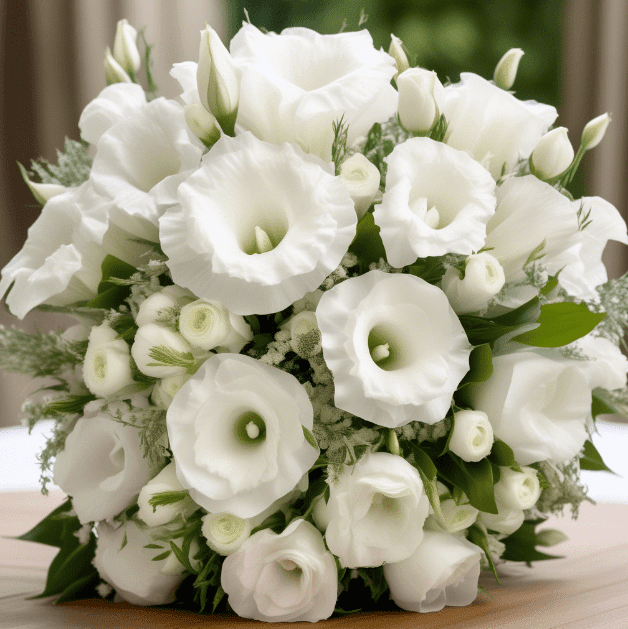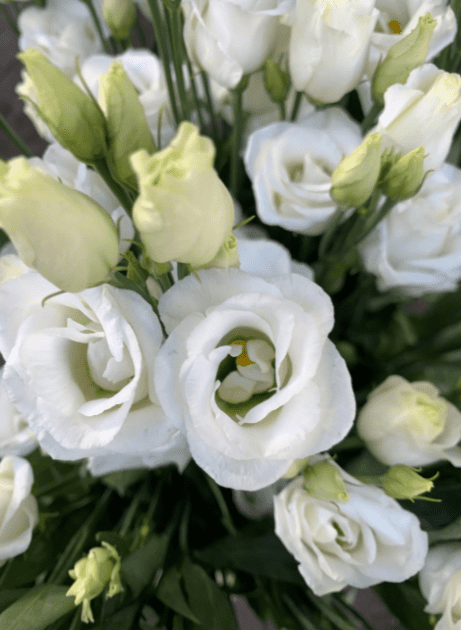
The white lisianthus, scientifically known as Eustoma grandiflorum, is a captivating flower that has gained immense popularity among florists and gardeners alike. Renowned for its delicate beauty and elegant appearance, this flower symbolizes charm and sophistication.
A Glimpse into the History of Lisianthus
The lisianthus is native to the warm regions of the United States, Mexico, the Caribbean, and South America. Its journey from wildflowers to a coveted bloom in floral arrangements is a fascinating tale of discovery and cultivation. People originally admired these flowers for their resilience and beauty in prairies. Their habitat and resemblance to other flowers led people to give them the common names “Texas Bluebell” and “Prairie Gentian”.
Etymology and Symbolism
The name “lisianthus” is derived from the Greek words “lysis,“ meaning dissolution, and “anthos,“ meaning flower. This name reflects the flower’s delicate and ephemeral nature. Lisianthus symbolizes appreciation, gratitude, and charisma in the language of flowers. The white variety, in particular, represents purity, innocence, and a timeless elegance.
Characteristics of White Lisianthus
- Physical Attributes: White lisianthus flowers are known for their stunning, rose-like appearance. They feature multiple layers of ruffled petals, creating a soft, full bloom. The petals are often pure white, though some varieties like “Powder White Lisianthus” have subtle hints of green or cream. The flowers can grow up to 5 centimeters in diameter and are borne on slender, sturdy stems that can reach up to 60 centimeters in height.
- Growth Habit and Blooming Season: Lisianthus plants have a bushy, upright growth habit. They are herbaceous perennials but are often grown as annuals in regions with colder climates. The blooming season for white lisianthus typically spans from late spring to early fall, with peak blooming occurring in the summer months. The flowers are known for their long vase life, making them a favorite for bouquets and arrangements among florists.
Cultivation and Care of White Lisianthus
- Ideal Growing Conditions: White lisianthus thrives in well-drained soil with a neutral to slightly acidic pH (between 6.5 and 7.0). They prefer full sun to partial shade, requiring at least six hours of direct sunlight each day. In terms of temperature, these flowers flourish in moderate climates and can be sensitive to extreme heat or cold.
- Planting and Propagation: Propagation of lisianthus is typically done through seeds, as they do not propagate well through cuttings or division. The seeds are tiny and require a fine seedbed. Here are some key steps for successful cultivation:
- Seed Sowing: Sow the seeds indoors 10-12 weeks before the last frost date. Sprinkle the seeds on the soil’s surface and lightly press them in, as they need light to germinate.
- Germination: Maintain a temperature of around 20-25°C (68-77°F) and moisten the soil. Germination can take 10-15 days.
- Transplanting: Once the seedlings have several true leaves and the danger of frost has passed, transplant them into the garden, spacing them 15-30 centimeters apart depending on the variety (e.g., 8-12 inches for cut flower production).
- Watering and Fertilization: Lisianthus plants require regular watering to keep the soil evenly moist but not soggy. Overwatering can lead to root rot, so it is essential to ensure proper drainage. Fertilize the plants every 4-6 weeks with a balanced, water-soluble fertilizer to promote healthy growth and abundant blooms.

Uses of White Lisianthus in Floristry and Landscaping
- Floristry: White lisianthus is a staple in the floral industry because of its aesthetic appeal and versatility. It is commonly used in:
- Bouquets: The elegant blooms add a touch of sophistication to bridal bouquets, anniversary arrangements, and other special occasion flowers. Depending on the desired look, they can be used as focal flowers (e.g., Powder Puff or Flare varieties) and filler flowers (e.g., Double-Flowered varieties).
- Arrangements: Florists often incorporate white lisianthus into mixed arrangements, where they complement other flowers and greenery beautifully.
- Boutonnieres and Corsages: Their delicate appearance makes them ideal for boutonnieres and corsages, adding a classic touch to formal attire.
- Landscaping: In gardens and landscapes, white lisianthus can be used to create stunning displays. They are perfect for:
- Borders and Edging: Their upright growth habit and beautiful blooms make them excellent choices for garden borders and edging.
- Containers and Pots: Lisianthus can be grown in containers, adding elegance to patios, balconies, and other outdoor spaces. Choose a pot with good drainage and use a well-draining potting mix.
- Cut Flower Gardens: Given their popularity as cut flowers, growing lisianthus in dedicated cut flower gardens can provide a continuous supply of fresh blooms. Plant with proper spacing (8-12 inches apart) to allow for air circulation and stem development.
Lisianthus as a Cut Flower
Beyond its ornamental value in gardens, lisianthus is prized for its use in floral arrangements. Here’s what you need to know:
- Lisianthus Vase Life: With proper care, cut white lisianthus can grace your arrangements for up to two weeks. To maximize vase life:
- Cut stems at a diagonal angle with sharp tools just before they reach full bloom.
- Use a clean vase with lukewarm water and a packet of flower food.
- Change the water every few days and recut the stems.
- Avoid placing near ripening fruit or drafts, as these can shorten vase life.
Conclusion
The white lisianthus symbolizes elegance and purity in the floral world. Its captivating beauty, combined with its versatility in both floristry and landscaping, makes it a cherished flower among enthusiasts. Gardeners and florists can fully appreciate and utilize this exquisite bloom by understanding its history, characteristics, and cultivation needs.
Whether you’re searching for the perfect flower for a special occasion arrangement or aiming to add a touch of elegance to your garden, the white lisianthus is sure to impress.

























